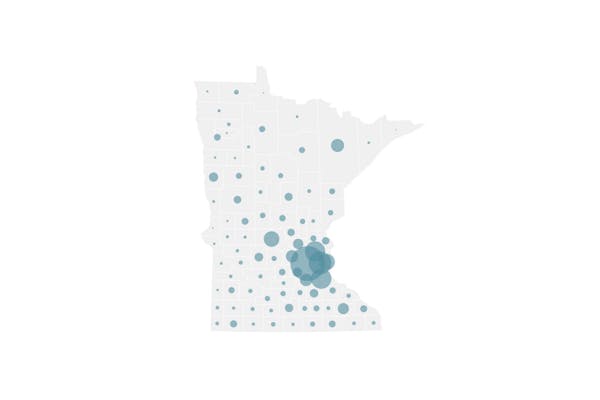Donor plasma from patients who have recovered from COVID-19 can reduce deaths in others if given early and at high enough doses, Mayo Clinic researchers found.
The discovery validates one of COVID-19's only known treatments, which will be relied on until an increase in vaccinations snuffs out the global pandemic, said Dr. R. Scott Wright, a coordinator of Mayo's national COVID-19 plasma therapy program.
"I think it behooves the medical community to continue to innovate and test therapies for treatment. Realistically, we're months away from having a substantial number of people vaccinated," Wright said.
The positive research news came Wednesday along with news that the latest pandemic wave in Minnesota appears to be settling down, despite concerns that holiday gatherings fueled transmission of the coronavirus that causes COVID-19.
The seven-day-average positivity rate of COVID-19 diagnostic testing rose from 4.7% on Dec. 24 to 7.5% on Jan. 4, but the rate of growth has tapered. The number of Minnesota hospital beds filled with COVID-19 patients declined to 665 on Tuesday after a slight increase earlier in the week.
The state has reported 5,774 COVID-19 deaths and 440,354 diagnosed infections, including 50 deaths and 1,504 infections added on Wednesday.
The Minnesota Department of Health on Wednesday reported that 146,901 people received at least one dose of Pfizer or Moderna COVID-19 vaccines, and that 7,928 completed the two-dose course.
Minnesota's federally controlled vaccine allocation exceeds 558,000 doses. Only a third of the doses have been used, but health officials stressed that none are sitting unspoken for in freezers and that some are in shipments that won't reach the state until next week.
"Vaccine is moving through the state, but the process takes time," said state infectious disease director Kris Ehresmann.
Heightened public interest in vaccines mirrors the attention plasma received last spring, when COVID-19 was new and the lack of known treatments raised fears.
Mayo early in the pandemic launched a nationwide expanded access program, linking hospitalized COVID-19 patients across the country with donor plasma, under the premise that plasma contained virus-fighting antibodies that would treat infections.
Researchers assessed their effectiveness by comparing outcomes of patients whose plasma contained high and low levels of the neutralizing antibodies that fight infections.
Reviewing 3,082 patients, they found a 25% lower chance of death among patients who received antibody-rich plasma vs. those whose infusions contained lower concentrations.
Outcomes were better for hospitalized patients who received plasma within three days of diagnosis and didn't need to be placed on ventilators due to lung damage.
"Patients who were on ventilator did not see a benefit," Wright said. "It was too late."
The study was published in the New England Journal of Medicine, which last week posted a study from Argentina showing similar results for plasma therapy in older adults.
Mayo's preliminary findings this summer convinced the U.S. Food and Drug Administration to grant emergency usage of plasma as an inpatient COVID-19 therapy.
An editorial accompanying the latest study said its results argue for conservation of limited plasma for those likely to benefit the most, though that means withholding it from some of the sickest patients.
Dr. Louis Katz of the Mississippi Valley Regional Blood Center in Davenport, Iowa, said only a fifth of plasma donations at his center contained antibody concentrations high enough to have the therapeutic benefit demonstrated in the study.
"Uncontrolled compassionate use of convalescent plasma … should be discouraged," he wrote, "even though clinicians recognize how difficult it can be to 'just stand there' at the bedside of a patient in the ICU."
Other COVID-19 treatments include the antiviral remdesivir and the steroid dexamethasone, which reduces risks of COVID-19 death by blunting overreactions by the immune system to infection.
HealthPartners is part of a national study examining whether plasma could be used as an outpatient treatment to prevent COVID-19 patients from needing hospital care.
The Bloomington-based health system also is scheduled to halt recruitment this week for a clinical trial of an experimental COVID-19 vaccine made by AstraZeneca.
The University of Minnesota, meanwhile, just started recruitment for a new trial of a Novavax COVID-19 vaccine and added an enrollment site on Wednesday at St. Joseph's Hospital in St. Paul.
"We want to find multiple effective vaccines to have more options," said Dr. Susan Kline, an infectious disease specialist at the U of M Medical School, "and to particularly be able to ramp up manufacturing and distribution more quickly."
State health officials this week said they are encouraging hospitals and clinics to accelerate the pace of COVID-19 vaccinations by providing more weekend appointments.
Limited vaccine in Minnesota is currently reserved for health care workers and residents of long-term care facilities. Broad public access to vaccine isn't expected until at least the spring.
Beyond vaccine, health officials encourage continued mask-wearing and social distancing to reduce the spread of the virus.
Infection numbers declined to the point that Gov. Tim Walz scaled back some protections — allowing bars and restaurants to resume indoor service at 50% capacities on Monday.
However, the governor on Wednesday extended his peacetime emergency order for another 30 days, giving him executive authority to implement policies such as public mask-wearing mandates to confront the pandemic.
Jeremy Olson • 612-673-7744

Souhan: This is KAT's chance to prove Flip Saunders was right

